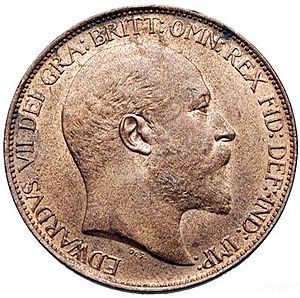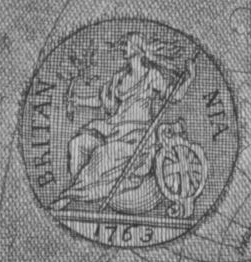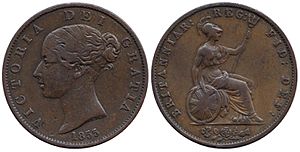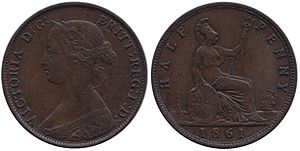History of the halfpenny facts for kids

The British halfpenny coin was a small coin that was worth 1/480th of a pound sterling. Imagine a pound as a big cake; a halfpenny was a tiny slice! For 700 years, this coin was an important part of British money.
At first, halfpennies were made of silver. But as silver became more valuable, the coins started to be made from cheaper metals. The halfpenny was finally stopped in 1969 when Britain changed its money system to decimal currency. People often called it a ha'penny, pronounced HAY-pə-nee.
For a long time, people thought the first halfpenny coins were made during the time of King Edward I (1272–1307). Before that, if people needed small change, they would "cut" larger pennies into halves or quarters. They usually cut along a cross shape that was on the back of the penny.
However, in recent years, people using metal detectors have found a few halfpennies from much older kings, like Henry I (1100–1135) and Henry III (1216–1272). These coins are super rare! They were all found near London and show that round halfpennies might have been used much earlier than we thought.
Contents
Early Silver Halfpennies
Some very old silver halfpennies from King Henry I have been found. These coins might have been test coins, but it seems some were used by people. The front of the coin shows the king's face and says "HENRIC REX" (King Henry). The back shows a cross and the name of the person who made the coin, like "GODWIN A ON WI" (Godwin of Winchester).
Later, during the time of King Henry III, two types of halfpennies were made in London. They were similar to the pennies but half the size. The front showed the king with a crown and a sceptre (a royal staff), saying "HENRICUS REX". The back had a small cross with four dots in each corner and the name of the money maker, like "TERRI (or ELIS) ON LUND" (Terry or Elis of London).
Halfpennies of Edward and Henry Kings
King Edward I (1272–1307) successfully brought in the halfpenny as part of his new money system. This helped trade grow a lot! Back then, the value of a coin wasn't written on it. Instead, its value came from how much silver it contained. So, a halfpenny was half the size and weight of a penny.
It can be hard to tell apart the hammered halfpennies from this time. They are small, often cut, and can be in poor condition. Also, the words on them were sometimes wrong because it was tough to make tiny coin dies. Kings Edward II, III, and IV also made halfpennies, which makes it even harder to tell them apart. Generally, Edward I's coins are a bit bigger.
Most of these coins were made at the London mint, which was in the Tower of London. Other mints also made coins, and the back of the coin usually said where it was made, like "CIVITAS LONDON" for London.
The king's name on the front usually said "EDW", "EDWA", or "EDWR". For Kings Richard II (1377–1399) and Henry IV (1399–1413), it would say "RICARD" or "HENRI".
During King Edward II's time (1307–1327), halfpennies were only made in London and Berwick. This was probably because his father had already made enough.
King Edward III (1327–1377) had three mints making halfpennies: London, Berwick, and Reading. English coins were very popular in Europe because they had good weight and metal. Other countries even copied English halfpennies!
King Richard II (1377–1399) made all his halfpennies in London. The front said "RICHARD REX ANGL" (Richard King of England) around his face.
The halfpennies of King Henry IV (1399–1413) are hard to identify because they are often worn or cut. The front said "HENRIC REX ANGL" (Henry King of England), and the back said "CIVITAS LONDON". In 1412, the halfpenny's weight was reduced.
The halfpennies of King Henry V (1413–1422) are a bit easier to spot, but the design stayed mostly the same.
During the first time King Henry VI was king (1422–1461), halfpennies were made in London and Calais (a city in France that was English territory then). They looked like the earlier Henry coins.
The halfpennies of King Edward IV (1461–1470) changed. Early coins were heavier and only made in London. Later, lighter coins were made in London, Bristol, Canterbury, York, and Norwich.
When Henry VI was briefly king again (1470–1471), halfpennies were made in London and Bristol.
King Richard III (1483–1485) only made halfpennies from the London mint. His coins can be told apart from Richard II's by the words "RICARD DI GRA REX" on the front.
Tudor Halfpennies
During the time of King Henry VII (1485–1509), halfpennies were mostly made in London, but also in Canterbury and York. Henry's coins look different from the earlier Henrys, with a new style of king's face and "HENRIC DEI GRA REX" on the front.
By the time of King Henry VIII, the halfpenny was becoming less important. Less care was taken to make them look good, so many are hard to read. His early coins looked like his father's, but the words on the front changed. Later, his coins had a more realistic face, but they were made with less silver and more copper, so they are often in bad condition.
In the short reign of King Edward VI (1547–1553), several types of halfpennies were made. Some had the king's crowned face and a cross on the back. Later coins had a rose on the front and the royal shield on the back. The silver in these last halfpennies was so poor that they were often used as farthings (even smaller coins).
No halfpennies were made during the reigns of Queen Mary I or for the first 20 years of Queen Elizabeth I's rule.
Queen Elizabeth I (1582–1602) did make a lot of halfpennies later in her reign. Because they were so small, they didn't have her face or any words on them. Instead, they had a portcullis (a gate) on the front and a cross on the back. Later coins also had a small mark to show the year.
17th-Century Silver Halfpennies
When King James I became king of England in 1603, his first halfpennies looked like Elizabeth I's. Later, they had a rose on the front and a thistle (a Scottish symbol) on the back.
Surprisingly, King Charles I (1625–1649) made very few halfpennies. The most common ones just had a rose on both sides. Another type had a rose on one side and plumes (feathers) on the other.
The very last silver halfpennies were made during the time of the Commonwealth (when England was a republic). These coins were very plain, with no words. They had a shield with a St George's cross on the front and the Irish harp on the back.
Base-Metal Halfpennies
When King Charles II became king (1660–1685), people really needed small coins for everyday shopping. The silver coins were being saved, so shopkeepers started making their own unofficial metal tokens. This was against the law, but the government knew people needed small change.
It's tricky to make low-value coins. If the coin costs more to make than its value, people might melt it down. If it costs less, people will make fake ones. The Royal Mint wasn't ready to make copper coins until 1672. That year, a special announcement said that copper halfpennies and farthings would be made. These new coins were worth their metal value plus the cost of making them. They could be used for payments up to six pence.
The new halfpennies showed Britannia (a female symbol of Britain) on the back. The Mint had trouble making enough copper, so they had to import it from Sweden. The first copper halfpennies finally appeared in late 1672 (which was still considered 1672 because the year ended in March back then).
Soon, the idea of coins being worth their metal content didn't last. The coins were given a slightly higher value than their metal, and fake coins quickly appeared.
Charles II's copper halfpennies showed his head facing left. They weighed about 10-12 grams and were 28-31 millimetres wide. The front said "CAROLVS A CAROLO" (Charles, son of Charles). The back showed Britannia with "BRITAN NIA" and the date (1672, 1673, or 1675).
The halfpennies of King James II (1685–1688) were made of tin with a small square of copper in the middle. Tin rusts easily, so not many of these coins are in good condition. The idea was to make a profit and make coins that were hard to fake, while also helping the tin mining industry. These coins had the king's head facing right and "IACOBVS SECVNDVS" (James the Second). Britannia was on the back. The date was unusual; it was on the edge of the coin!
During the joint reign of King William III and Queen Mary II (1689–1694), tin and copper halfpennies continued. But people didn't like the tin coins because they didn't feel valuable and they corroded. Even worse, fake lead coins started appearing. Just before Queen Mary died in 1694, a copper halfpenny was brought back. These copper coins weighed about 9-11 grams and were 28-31 millimetres wide.
The front of these coins said "GVLIELMVS ET MARIA". The back said "BRITANNIA" with the date.
After Queen Mary's death, King William III continued making copper halfpennies. But the quality of the coins got worse. The people making them were cutting corners, using cheap labor, and even making mistakes in the words on the coins! It's strange because at the same time, the Mint was making very high-quality gold coins. By 1698, there were too many copper coins, and laws were passed to try and stop new ones from being made.
William III's halfpennies had his head facing right and "GVLIELMVS TERTIVS" (William the Third). Britannia was on the back with "BRITANNIA" and the date. These coins were made every year from 1695 to 1701.
Because there were so many copper coins already, no copper halfpennies were made during the reign of Queen Anne (1701–1714).
The United Kingdom Halfpenny

Soon after King George I became king (1714–1727), all the extra copper coins were used up. In 1717, new halfpennies were made. These first ones (1717-1718) were called dump halfpennies because they were smaller and thicker than before, weighing about 9-10 grams and 25-27 millimetres wide. They were well-made, with a clear image of King George's head facing right and "GEORGIVS REX" on the front. Britannia was on the back with "BRITANNIA" and the date. Later, from 1719-1724, the coins were made larger, but with the same weight of metal.
King George II (1727–1760) made the most halfpennies yet. But there were also tons of fake coins! It's hard for us today to imagine how many fake coins were in circulation back then. Sometimes, there were more fake coins than real ones! Many real coins were melted down to make lighter, fake ones. Halfpennies were made almost every year between 1729 and 1754. They weighed about 9-10 grams and were 28-30 millimetres wide. The front showed King George's head facing left and "GEORGIVS II REX". Britannia was on the back with "BRITANNIA" and the date.
Fighting Fake Coins
During the reign of King George III (1760–1820), the first halfpennies didn't appear until 1770. Fake coins were a huge problem. In 1771, making fake copper coins became a very serious crime, but it didn't stop people much. For the next 20 years, most copper coins in use were fakes.
A famous manufacturer named Matthew Boulton wrote in 1789 that he often received two-thirds fake halfpennies when traveling. He said that even factory owners were paying their workers with fake money! Boulton later made the famous "Cartwheel" pennies and twopences in 1797, which were very heavy and hard to fake. He wanted to make halfpennies too, but the government said no at first. They thought there were already so many fake halfpennies that if Boulton made real ones, he wouldn't be able to keep up with the demand.
But people really wanted real halfpennies, so the government changed its mind. In 1798, Boulton was asked to make halfpennies and farthings dated 1799. However, the price of copper had gone up, so the coins were made a bit lighter. People weren't as happy with them. In 1806, Boulton made even more halfpennies, but the copper price had risen again, so they were even lighter. This time, people didn't complain, maybe because they weren't so focused on the "intrinsic value" (the value of the metal itself) anymore.
Halfpennies from 1800 to 1970
George III halfpennies were made in three main periods:
- 1770–1775: These weighed about 9-10 grams and were 29-30 millimetres wide. The front showed the king's head facing right, with "GEORGIVS III REX". The back showed Britannia holding a spray and a spear, with "BRITANNIA" and the date.
- 1799: These were heavier, about 12-13 grams, and 30-31 millimetres wide. The front said "GEORGIVS III DEI GRATIA REX". The back had a new design of Britannia and "BRITANNIA 1799".
- 1806–1807: These were lighter again, about 9-9.8 grams, and 29 millimetres wide. The front said "GEORGIVS III D G REX" with the date. The back had a slightly different Britannia and "BRITANNIA".
After the Royal Mint moved to a new location, making gold and silver coins became the main focus. Copper coins weren't made again until George IV became king (1820–1830). New halfpennies didn't appear until 1825. This delay led to William Wyon designing the coins, and his designs are considered some of the most beautiful British coins ever.
The George IV halfpenny (1825–1827) weighed about 9-9.5 grams and was 28 millimetres wide. The front showed King George IV's head facing left, with "GEORGIUS IV DEI GRATIA" and the date. The back showed Britannia wearing a helmet, with a shield and trident, and "BRITANNIAR REX FID DEF". The date was placed under the king's head, and symbols like the rose, thistle, and shamrock were under Britannia.
The halfpenny of William IV (1830–1837), made in 1831, 1834, and 1837, looked similar to George IV's, but with the new king's head facing right and "GULIELMUS IIII DEI GRATIA" and the date.
The halfpennies of Queen Victoria's long reign (1837–1901) come in two main types:
- Copper coins (1838–1860): These were similar to the previous kings' halfpennies, weighing about 9-9.5 grams and 28 millimetres wide.
- Bronze coins (1860–1901): These were lighter, about 5.5-5.8 grams, and 25 millimetres wide. For the first time, the words "HALF PENNY" were on the back! The date was also under Britannia. The queen's portrait changed from a "young head" to an "old head" in 1895. Some coins made in Birmingham had a small "H" mark under the date. Halfpennies were made almost every year of Victoria's reign.
Halfpennies weighing 5.67 grams (one fifth of an ounce) and 25.4 millimetres wide (which became the standard size) were made almost every year of King Edward VII's reign (1901–1910). They looked similar to the later Victoria coins, but with the king's head facing right.
George V's reign (1911–1936) saw halfpennies made every year with the same design. The front showed the king's head facing left, and the back had the usual Britannia. Some of these coins had a problem called "ghosting," where the image from one side partly showed through to the other. They tried to fix this in 1925 and finally in 1928.
A halfpenny was designed for King Edward VIII, but it was only a pattern coin, meaning it was a sample waiting for approval. The king gave up his throne in December 1936, so it was never officially made. He wanted his left profile on the coin, breaking a tradition. Also, for the first time since 1672, Britannia was replaced on the back by a sailing ship, said to be Sir Francis Drake's Golden Hind. This ship design stayed on the halfpenny for the rest of its history.
Halfpennies with a similar ship design were made every year during the reign of King George VI. The words on the front changed slightly after 1948.
Unlike the penny, Elizabeth II's reign (1953–1967) saw halfpennies made every year except 1961. The back was the same ship design. The front showed the queen's head, and the words on the front changed slightly after 1953.
The old halfpenny coin stopped being official money in 1969.
The new two pence coin, which came out when Britain switched to decimal money in 1971, is almost the same size as the last halfpenny coins.
Cricket Connection
Broadhalfpenny Down, a very important place in the history of cricket, got its name from the halfpenny coin!




